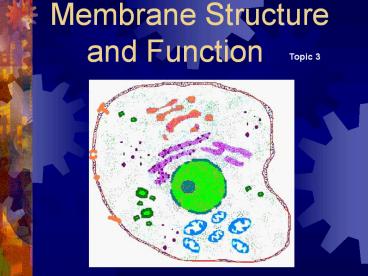Membrane Structure and Function - PowerPoint PPT Presentation
1 / 57
Title:
Membrane Structure and Function
Description:
Membrane Structure and Function Topic 3 Membrane Structure Phospholipid bilayer Amphipathic liquid-crystal properties/behavior allow for constant movement of HC ... – PowerPoint PPT presentation
Number of Views:257
Avg rating:3.0/5.0
Title: Membrane Structure and Function
1
Membrane Structure and Function
Topic 3
2
Plasma Membrane Functions
Maintain a high concentration of materials in the
cell.
Keep harmful materials out.
Control the movement of materials into and out of
the cell.
Let the cell sense its environment.
3
Membrane Structure
- Phospholipid bilayer
- Amphipathic
- liquid-crystal properties/behavior allow for
constant movement of HC tails
4
The Plasma Membrane is Semipermeable
5
(No Transcript)
6
(No Transcript)
7
Davson-Danielli vs. Fluid Mosaic
8
Membrane Characteristics
- self-sealing
- Flexible
- Tend to form vesicles
- (ENDOCYTOSIS)
- Tend to fuse w/ other bilayers
- (EXOCYTOSIS)
9
(No Transcript)
10
LIPID MOBILITY
11
http//www.d.umn.edu/sdowning/Membranes/phospholi
pidlateralmovanim.html
http//www.d.umn.edu/sdowning/Membranes/phospholi
pidrotationalanim.html
12
Relationships w/ other intracellular membranes
- Nuclear Rough
- Memb. ER
- vesicles
- Golgi Bodies
- lysosomes vesicles
cell memb - vacuoles
13
MEMBRANE PROTEINS
- Integral Proteins
- Anchored into membrane
- Transmembrane proteins
14
- Peripheral Proteins
- no anchoring to membrane
- often bound to exposed regions of integral
proteins
15
(No Transcript)
16
(No Transcript)
17
(No Transcript)
18
PROTEIN MOBILITY
http//www.d.umn.edu/sdowning/Membranes/proteinmo
bilityanim.html
19
Proteins Are Critical to Membrane Function
20
Membrane Protein Functions
- Cell Adhesion
- Communication Channels
- Transport Channels
- Signal Receptors btwn. Ext/Int cell
- Attachment Sites
- Pumps
- Enzymes
- Peripheral
- Integral
- Integral
- Integral
- Peripheral
- Integral
- Both
21
Protein Signaling
http//www.d.umn.edu/sdowning/Membranes/signaling
anim.html
22
Membrane Components
Phospholipids
Proteins (peripheral and integral)
Cholesterol
Carbohydrates
23
The Plasma Membrane Gateway to the Cell
24
MOVEMENT ACROSS THE CELL MEMBRANE
25
Transport Processes - Diffusion
Solutes move down a concentration gradient until
they are evenly distributed. This is diffusion.
Another way of saying this is that solutes move
from a region of higher concentration to a region
of lower concentration until there is no
difference in concentration.
26
Methods of Movement
- PASSIVE TRANSPORT
- DIFFUSION
- SIMPLE DIFFUSION
- OSMOSIS
- FACILITATED DIFFUSION
27
Three Forms of Transport Across the Membrane
28
- ACTIVE TRANSPORT
- PUMPS
- EXOCYTOSIS
- ENDOCYTOSIS
- PHAGOCYTOSIS
- PINOCYTOSIS
- RECEPTOR-MEDIATED
29
DIFFUSION
- Cell obtains / releases substances by taking
advantage of natural properties of movement
(kinetic E)!
30
Diffusion is
- NET movement of mcls from
- Down the gradient . NO Energy required.
31
Rate of Diffusion influenced by
- Size / shape of molecules moving
- Electrical charges across membrane
- Temperature ( movement,
- . Diffusion )
32
- Substances diffuse down their own gradient
- NOT affected by gradient of other
substances !!
33
Diffusion continues until
- Dynamic
- Equilibrium
- is
- reached!
34
(No Transcript)
35
OSMOSIS
- Diffusion of water across the semi-permeable
plasma membrane. - Water moves down its own gradient.
- Zones of Hydration
36
Spheres of Hydration
37
Osmotic Pressure
- tendency of water to move into a solution by
osmosis. - High solute low water
- High Osmotic Pressure
38
Comparing Solutions
- HYPOTONIC
- refers to the less concentrated
- (more dilute) of two solutions.
39
- HYPERTONIC
- refers to the more concentrated
- (less dilute) of two solutions.
40
- If a cell is placed in a hypotonic solution, the
cell will. - S W E L L and
- B U R S T !!
- Turgidity issues
41
(No Transcript)
42
- If a cell is placed in a hypertonic
- solution, the cell will
- S H R I N K !
- (CRENATION)
43
(No Transcript)
44
(No Transcript)
45
(No Transcript)
46
- ISOTONIC
- refers to two solutions where there is no net
movement of water between the two.
47
- a cell is placed in an isotonic solution, there
will be. - no net movement of water
- into / out of the cell.
48
The Problem of Osmotic Pressure
- Whats the risk?
- How can osmotic pressure be minimized?
49
- Live in an isotonic enviroment
- Contractile vacuoles
- plasmolysis
- Marine invertebrates
- Human RBCs
- Unicellular protists
- Plant cells
50
Contractile Vacuoles
51
Plasmolysis Cell Wall Action
52
(No Transcript)
53
(No Transcript)
54
(No Transcript)
55
(No Transcript)
56
(No Transcript)
57
Transport Problems ?
- CYSTIC FIBROSIS
- LIDDLES SYNDROME































